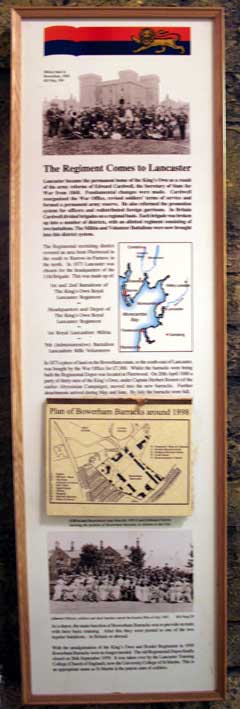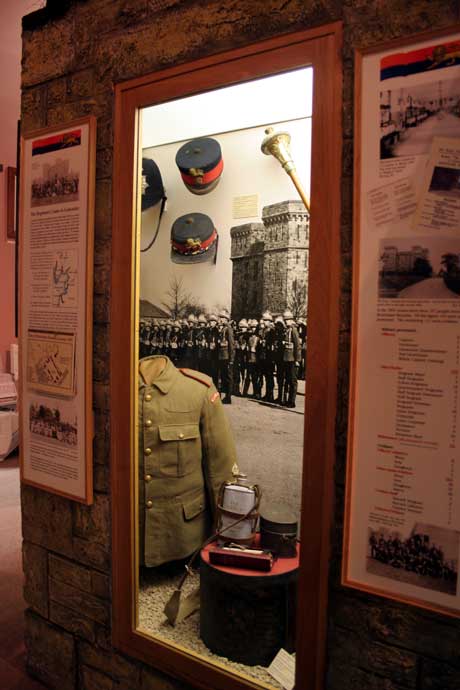Museum Display Information
The Regiment Comes to Lancaster


Lancaster became the permanent home of the King’s Own as a result of
the army reforms of Edward Cardwell, the Secretary of State for War from
1868. Cardwell reorganised the War Office, revised soldiers’ terms of
service, formed a permanent army reserve, reformed the promotion system
for officers, and redistributed the foreign garrisons.
In Britain Cardwell divided brigades into a regional basis. Within each
brigade there would be a number of districts to which regular regiments
(each consisting of two battalions) would be allotted. Added to this
were the Militia and Volunteer Battalions.
In 1873 Lancaster was chosen for the headquarters of the 11th Brigade.
This comprised:
1st and 2nd Battalions of The King’s Own Royal Lancaster Regiment
Depot of The King's Own Royal Lancaster Regiment
1st Royal Lancashire Militia
5th (Administrative) Battalion Lancashire Rifle Volunteers
The Regimental recruiting district covered an area from Fleetwood to
Barrow-in-Furness.
In 1873 a piece of land on the Bowerham estate, south Lancaster, was
purchased on behalf of the War Office for £7,300. Whilst the barracks
were under construction the Regimental Depot was located at Fleetwood.
On 20th April 1880 a party of thirty men of the King’s Own, under
Captain Herbert Borrett (of Abyssinia fame), were the first to occupy
the barracks. Further detachments arrived during May and June and, by
July, the barracks were full.
The main function of Bowerham Barracks, as a depot, was to provide
recruits with their basic training. After this they were posted to one
of the two regular battalions - either in Britain or abroad.
The Regimental Depot finally closed on 26th September 1959. It was taken
over by the Lancaster Training College (Church of England), later The
University College of S. Martin and presently the Lancaster Campus of
the University of Cumbria.

Objects on display:
2nd Battalion side drum from around 1910.
Accession Number: KO 0750/28
D Shaped mess tin.
Accession Number: KO1546/03
Swagger canes, carried by senior NCOs and officers.
Colour Sergeant Morrell, used 1889-1909.
Accession Number: KO0885
Lieutenant Sommerville, used 1879-1919.
Accession Number: KO1068/04
Leather folder containing the documents of Private Alfred Lawton.
Accession Number: KO2176/01
Forage cap worn by Sergeant Harrison in 1879.
Accession Number: KO 0001/01
Officer’s forage cap from 1881-1900.
Accession Number: KO 0352/01
Other ranks helmet, 1st Volunteer Battalion.
Accession Number: KO 1294/01
Colour Sergeant’s tunic of the type worn from 1886 onwards.
Accession Number: KO 0856/01
Set of Simplex Valise Equipment including three-part D- shaped mess tin,
leather belts, braces and pouches issued to the 4th Volunteer Battalion
around 1898. This set is named to Colour Sergeant Preston of C Company,
Dalton in Furness, around 1898.
Purchased. KO 2183/01
Water bottle from Simplex Valise Equipment, marked 4th Volunteer
Battalion RLR.
Accession Number: KO 2183/30
1902 pattern khaki service dress tunic worn between 1902 and 1904. Note
the unusual ‘R. Lancaster’ shoulder titles as apposed to the usual
‘King’s Own’.
Accession Number: Purchased. KO 2183/01
2nd Volunteer Battalion drummer boy tunic, from 1900-1904.
Accession Number: KO 1542/01
© Images are copyright, Trustees of the King's Own Royal Regiment Museum.
You must seek permission prior to
publication of any of our images.
Only a proportion of our collections
are on display at anyone time. Certain items are on loan for display
in other institutions. An appointment is required to consult any of
our collections which are held in store.




